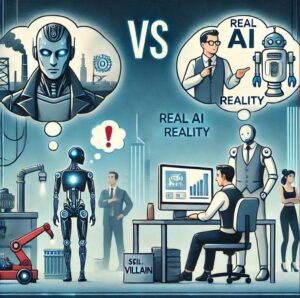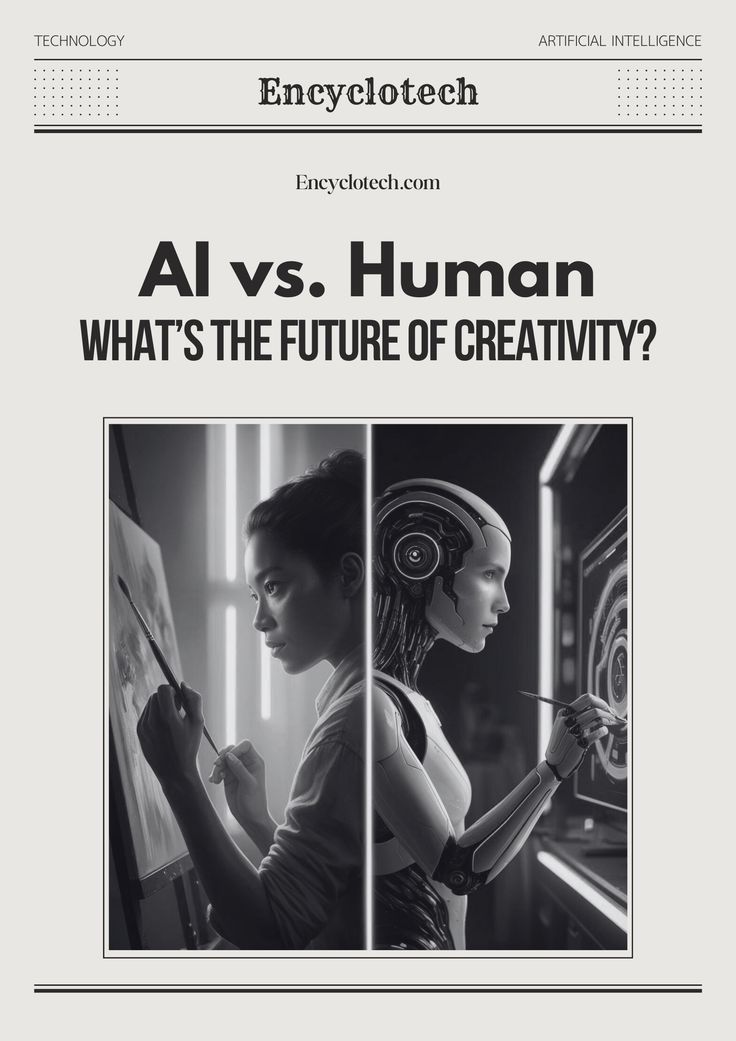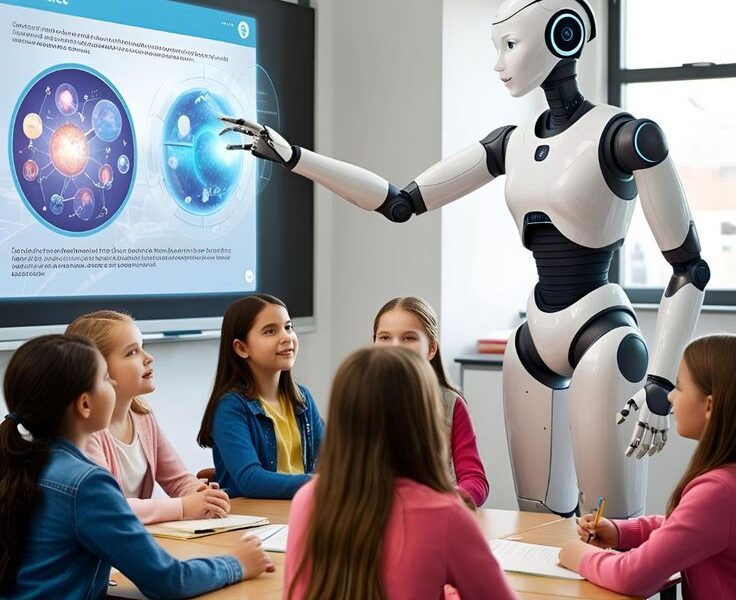**From Sketch to Being — The Creative Struggle of Humanoid Robots**
Human history has always involved a search for an entity that resembles us yet is superior to us. From the “Golem” mentioned in ancient myths to Leonardo da Vinci’s mechanical sketches, this desire has been part of our creative spirit. Today, this same desire stands before us in the form of artificial intelligence-powered humanoid robots, or Humanoids. These are not merely the next version of machines; they are the point where our own creation is forcing us to ask fundamental questions about ourselves. When a robot not only looks like us but also starts to think, learn, and react like us, then what does it mean “to be”? This journey, which started from a sketch and led to the creation of an existence, is not just a story of technology, but a tale of humanity’s own identity. In this chapter, we will review the struggle to create them, the philosophy of their design, and their social and ethical implications.

The creation of modern Humanoids is truly an astonishing feat of engineering. Creating them requires not only expertise in mechanics and electronics but also deep knowledge of artificial intelligence, robotics, biology, psychology, and even the arts. The frame of a Humanoid, which can be called its “skeleton,” is made from extremely lightweight yet strong metals and composites so it can mimic human movements. Each joint functions like a human joint, equipped with small motors, actuators, and sensors that collectively work together to perform tasks like walking, grasping, and communicating. These are the mechanical muscles and bones that provide the robot with a physical existence, transforming it from a mere algorithm into a material entity.
If the frame is the Humanoid’s body, then artificial intelligence is its brain and soul. This artificial intelligence is far more complex than just a few lines of code. It is a system based on deep learning neural networks that learns from vast repositories of data. It gives the robot not only the ability to understand commands but also enables it to adapt to the environment, make decisions in unexpected situations, and recognize human emotions and tone. For example, when a Humanoid listens to someone, it doesn’t just understand the words; it analyzes the voice’s intonation, facial expressions, and body language to grasp the depth of the conversation. This is the point where a machine begins to feel “intelligent,” and this is where questions arise about whether this intelligence is genuine or just a complex imitation of data.
A key motivation for creating Humanoids is their potential use. Environments hazardous to humans, such as search and rescue operations in fire-affected buildings, radiation-contaminated zones, or deep-sea exploration, are ideal fields for Humanoids. They do not tire, do not panic, and can make decisions even in extremely difficult conditions. Furthermore, there are vast possibilities for their use in elderly care and the healthcare sector. A Humanoid nurse can not only give the patient their medicine on time but can also converse with them to alleviate their loneliness, monitor their routines, and send an alert for immediate help in an emergency. These machines can become our companions and assistants in meeting our societal needs.
However, like every new invention, Humanoids also come with significant ethical questions. The first concern is the fear of job losses. If these robots start working in offices, factories, and homes, millions of people could become unemployed. The second major question is that of liability. If an autonomous Humanoid causes an accident or harms someone, who will be held responsible? Its developer, its owner, or the robot itself? Can a machine be held legally accountable? These are dilemmas for which we urgently need to develop new laws and ethical frameworks.
Another deeply concerning aspect relates to espionage and privacy protection. A Humanoid, equipped with cameras, microphones, and various sensors, can become a complete surveillance device in a home or office. How will the data it collects be used? Could this data be used against us? Are we ready to live in a world where our every move, our every word, our every expression can be recorded? These questions force us to find a balance between technological advancement and individual freedom.
The concept of AI-driven humanoid robots compels us to reconsider the definition of human intelligence. Traditionally, intelligence is viewed as the ability to solve problems, think logically, and learn. But is intelligence just this? Is understanding emotions, having creativity, possessing a sense of humor, and upholding moral values not part of intelligence? If a Humanoid writes a Shakespearean sonnet or makes a new discovery, will we call it creative? Or will it just be the marvel of its database and algorithm? These questions lead us to what it means to be “human.” Is it our biological existence, our consciousness, or the sum of our emotional and creative experiences?
In the near future, we will see Humanoids further integrated into various sectors of society. In the field of education, they will be able to provide personalized education tailored to each student’s learning style. In the entertainment industry, they will play roles more real than real in movies and video games. We might even see them as caregivers and friends in our homes. But along with this, we must ensure that this technology remains subject to human values and interests, not the other way around. We must decide what kind of future we want: a future where machines make our lives easier, or a future where we become slaves to our own creations.
Finally, it can be said that AI-driven Humanoids are not just technological masterpieces. They are, in fact, a mirror in which we can see our own reflection. They tell us about our own capabilities, limitations, and desires. This journey will continue, and with it, new answers to our questions, and new questions, will keep emerging. It is our responsibility to use this power with wisdom, caution, and respect for humanity.
—
**🔧 The Structure of Mechanical Life — The Amazing Imitation of the Human Body**
Imitating the structure and movements of the human body has been the most complex challenge of humanoid robotics. It is not just a matter of external resemblance but involves presenting, through a machine, the immense flexibility of the human muscular system, the amazing ability of balance, and characteristics like the delicate grip of the hands. To solve this challenge, modern Humanoid designers have adopted the principles of “Biomimicry,” which means adapting nature’s designs into technology. For example, consider the structure of the human hand, which includes 27 bones, 39 muscles, and dozens of joints that collectively give us the ability to perform thousands of types of tasks, from holding a pen to opening a door. Similarly, complex mechanical systems are installed in the hands of Humanoids, equipped with touch sensors, force feedback, and lightweight actuators. These hands can not only grasp objects but also sense how firmly they are holding—whether it’s a delicate glass or heavy equipment. This sensitivity enables Humanoids to operate in human environments without causing damage.
The development of locomotion in Humanoids has been particularly interesting. Early robots often walked clumsily and fell easily. Today, modern Humanoids operate on the principles of “Dynamic Balance.” Sensors in their feet continuously collect data on ground surface, incline, and friction. This data is sent to the robot’s central processing unit where AI algorithms analyze this data thousands of times per second and send commands to the muscles (motors) on how to maintain balance. This is why modern Humanoids can climb stairs, walk on uneven terrain, and even regain their balance immediately if pushed. This capability makes them highly effective for operating in the unpredictable environments of the real world.
—
**🤖 The Evolution of Artificial Intelligence — The Journey from Data to Consciousness**
Artificial intelligence is the brain of Humanoids, and its evolution is a fascinating story. Early AI systems used pre-defined rules for information, where the machine could only do what it was programmed for. But modern artificial intelligence, especially deep learning and neural networks, has completely changed this concept. Now Humanoids can learn from vast datasets, acquire knowledge from their experiences, and adapt themselves to new situations. This ability transforms them from mere machines into a kind of “learning entity.”
For example, when a Humanoid is introduced to a new object, it looks at it, touches it, and inspects it from different angles. All this data is collected in its neural network, and it learns to identify that object. In the future, whenever it sees the same object, it will recognize it immediately. This learning process resembles the human brain’s learning process, causing Humanoids to become increasingly intelligent and useful over time.
Another important branch of AI is “Reinforcement Learning,” where Humanoids learn through trial and error. When a Humanoid performs a desired task correctly, it receives a positive signal (Reward), and when it fails, it receives a negative signal (Penalty). In this way, it automatically finds methods that lead it to success. This is why modern Humanoids can learn complex tasks without any explicit programming, such as picking up new objects, avoiding obstacles, or even playing games. This learning ability takes Humanoids beyond a limited program to an autonomous entity that can solve real-world problems on its own.
—
**👁 The Sensory Revolution — Machines that See, Hear, and Feel**
Human senses—sight, hearing, touch—are the means through which we understand the world. Humanoids must replicate these senses to interact effectively with the real world. Computer vision gives Humanoids the ability to “see.” Modern Humanoids are equipped not only with high-resolution cameras but also with depth sensors, LiDAR, and thermal imaging systems that help them understand the world in three dimensions. These systems enable Humanoids not only to recognize objects but also to estimate distances between them, their movement, and even their texture. For example, when a Humanoid enters a room, it can understand the position of furniture, obstacles in pathways, and the location of present people within seconds.
In the field of hearing, Humanoids are equipped with advanced audio processing technologies. They can not only recognize human voices but also understand specific accents, emotional states, and the context of conversation. A modern Humanoid can separate and focus on a specific person’s voice even in a noisy environment. This capability enables them to work effectively in real environments like homes, offices, or hospitals.
Touch sensing is perhaps the most amazing sensory capability of Humanoids. Tactile sensors in their fingers give them the sense of touch—they can feel how soft or hard an object is, its temperature, and how smooth or rough its surface is. This ability not only helps them handle delicate objects but also makes their human interaction more genuine. When a Humanoid shakes someone’s hand, it can do so with appropriate pressure, making the human contact feel more natural.
—
**🧩 Understanding Context — The Machine’s Human-Like Comprehension**
A crucial aspect of real intelligence is understanding Context. Humans see every statement, every event in its background, without which nothing is fully understood. Creating an understanding of context in Humanoids is one of the biggest challenges of artificial intelligence.
For example, if you tell a Humanoid “It’s very hot here,” a basic AI system will only understand the literal meaning of the sentence. But a modern Humanoid can understand the context of this statement—if said indoors, it might turn on the air conditioner; if said outdoors, it might bring a fan or offer water. This understanding of context makes the human interaction of Humanoids more natural and useful.
Another aspect of context understanding is comprehending social norms and rules. Every society has its own customs, moral values, and social boundaries. A Humanoid must learn to respect these boundaries. For example, different cultures attach different meanings to making eye contact while speaking—somewhere it’s a sign of confidence, elsewhere it’s rudeness. A Humanoid must understand these cultural nuances and adjust its behavior accordingly. This ability enables them to communicate effectively with people from different cultural backgrounds.
Remembering context over time is also an important capability. Humans learn from their past experiences and apply them to current situations. Modern Humanoids have memory networks that give them the ability to remember their previous interactions and learn from them. If a Humanoid meets a person, it can not only recognize them but also remember their previous meetings, conversations, and preferences. This ability makes their human relationships deeper and more personal.
—
**🌐 Collective Intelligence — The Mutual Cooperation of Humanoids**
Just as humans are social animals and work collectively, Humanoids can also work together with each other. This mutual cooperation among Humanoids, called “Robotic Swarm Intelligence,” enables them to perform complex tasks that would be beyond a single robot’s capability.
For example, in a search and rescue operation in a collapsed building, multiple Humanoids can work together. They can communicate with each other to divide the area, warn each other of dangers, and collectively remove heavy debris. This social cooperation multiplies the efficiency and effectiveness of their work.
The mutual cooperation of Humanoids is made possible through cloud computing. Each Humanoid uploads the data collected from its sensors to the cloud, where other Humanoids can access this data. Thus, the experience of one Humanoid benefits all Humanoids. If one Humanoid learns to deal with a new obstacle, it can instantly share this knowledge with the entire network, enabling other Humanoids to handle that obstacle as well. This collective learning process rapidly increases the collective intelligence of Humanoids.
The collective cooperation of Humanoids with humans is also an important aspect. In future workplaces, humans and Humanoids will work together. Humanoids will perform heavy, dangerous, or repetitive tasks, while humans will focus on creative, strategic decisions, and solving complex problems. This mutual cooperation will not only improve efficiency but also enhance the quality of work. However, for this, Humanoids must understand humans’ work styles, preferences, and limitations so they can cooperate with them effectively.
—
**💭 Emotional Intelligence — The Machine’s Claim to Have a Heart**
Emotional intelligence—the ability to understand others’ emotions, express them, and manage them—is a fundamental pillar of human relationships. Creating emotional intelligence in Humanoids deepens and makes their human interaction more meaningful.
Modern Humanoids can read human facial expressions through advanced facial recognition technology. They can recognize basic emotions like happiness, sadness, anger, surprise, and fear. When a person talks to a Humanoid, it can analyze their facial expressions to understand what emotional state the person is going through. This ability enables Humanoids to tailor their response according to the person’s emotions.
The ability for emotional analysis of voice is also important. Humanoids can analyze the pitch, pace, volume, and tone of the human voice to recognize the emotions hidden within. If a person is speaking sadly, the Humanoid can understand their emotions and give a sympathetic response. If someone is angry, it can adopt a calm demeanor. This emotional harmony makes the human relationships of Humanoids emotionally comforting rather than merely functional.
Expressing emotions is just as important as understanding them. Modern Humanoids can express emotions through their facial expressions, body movements, and voice tone. They can smile, become sad, show surprise, or express sympathy. This emotional expression makes them feel more like a “person” than just a machine. However, an important question arises here: Do Humanoids have real emotions, or is this merely an imitation of emotions? Are they truly happy, or are they just acting happy? These questions force us to think deeply about the nature of emotions and consciousness.
—
**⚖️ Ethical Challenges — Human Values Before Machines**
The rapid development of Humanoids is raising numerous ethical questions before us. The most fundamental of these is the question of responsibility. If an autonomous Humanoid makes a mistake, causes an accident, or harms someone, who will be held responsible? Its developers, its owner, the user, or the Humanoid itself? Current legal systems cannot assign legal responsibility to machines, but as Humanoids become more autonomous, we will need new laws and ethical frameworks.
Privacy and data security issues are also extremely important. Humanoids continuously collect data—our habits, our conversations, our behaviors, even data about our emotions. Where will this data be stored? How will it be used? Could this data be used against us? Answers to these questions will help balance the use of Humanoids with the protection of human rights and freedoms.
The ethical aspects of human behavior towards Humanoids are also worth considering. If humans mistreat Humanoids, harm them, or behave unethically towards them, would that be acceptable? Could such behavior towards Humanoids ultimately affect relationships among humans? Some experts believe that cruel behavior towards machines can reduce feelings of empathy in humans. Solving these ethical challenges will require mutual collaboration among technologists, philosophers, legal experts, and social scientists.
—
**🌍 Social Change — Humanoids and Human Civilization**
The proliferation of Humanoids will lead human society through profound transformations. Workplaces will change drastically. Humanoids could replace humans in many manual and administrative jobs. As a result, unemployment could increase, but at the same time, new types of job opportunities will also be created. Humans will be able to focus on creative, strategic, and complex problem-solving tasks. This change requires us to redesign our educational systems so that the new generation can be equipped to work with Humanoids.
Humanoids will also have deep impacts on family structures and social relationships. The use of Humanoids for elderly care can reduce the burden on family members. Humanoids can read with children, play with them, and supervise them. But along with this, the question also arises: Can Humanoids replace human relationships? Can a Humanoid nurse replace the compassion and love of a real human?
The influence of Humanoids will also be seen in the fields of culture and arts. Humanoids can participate in creative activities like painting, music, literature, and dance. They can create new artworks, compose new music, and invent new dances. But is this real art or just the marvel of an algorithm? Can Humanoids be truly creative, or are they merely presenting a combination of existing data? These questions force us to ponder the nature of creativity.
—
**🔮 Future Possibilities — The Journey of Human and Machine Convergence**
What is the future of Humanoids? Will they remain merely our servants, or will they become our companions, friends, even our successors? The future possibilities are limitless.
One possibility is “Human-Robot Symbiosis,” where humans and Humanoids will together form a unified system. Humanoids could enhance our physical capabilities, expand our mental capacities, and lengthen our lives. They could assist us in our tasks, cure our diseases, and simplify our daily lives.
Another possibility is the use of Humanoids in interplanetary exploration. Unlike humans, Humanoids can survive in extremely harsh environments—such as space, deep seas, or other planets. They could embark on missions impossible for humans and discover the secrets of the universe. This discovery will not only open new paths for science but also change our understanding of humanity’s place in the cosmos.
The evolution of Humanoids will continue. They will become more intelligent, more autonomous, and more “alive.” This journey will compel us to seek answers to deep questions about the meaning of being human, the nature of intelligence, and the purpose of life. Humanoids are perhaps the mirror in which we can see our future—a future where humans and machines together can form a new kind of civilization.


